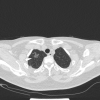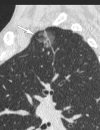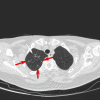Lung cancer coexisting with Papiliotrema flavescens infection diagnosed by next-generation sequencing: a case report
- PMID: 35945495
- PMCID: PMC9361596
- DOI: 10.1186/s12879-022-07591-0
Lung cancer coexisting with Papiliotrema flavescens infection diagnosed by next-generation sequencing: a case report
Abstract
Background: Papiliotrema flavescens is a rare environmental yeast, which has been isolated from air, trees, kernels of wheat and corn, fermenting soya sauce, and cerebrospinal fluid of patient with AIDS. Additionally, it is also reported to cause subcutaneous infection in a dog. In this case, we describe primary lung adenocarcinoma coexisting with Papiliotrema flavescens infection in a female patient diagnosed by next-generation sequencing (NGS) technique, which is the first such reported case.
Case presentation: The patient was a 52-year-old female with recurrent cough for 3 months. Chest CT examination revealed a ground glass nodule of 17 * 23 * 18 mm in the right upper lung, and 3 new pulmonary nodules appeared around it 2 months later. The patient underwent right upper lobe lobectomy and pathology confirmed that the primary 2-cm-lesion in the right upper lobe was invasive lung adenocarcinoma, and two of the three surrounding lung nodules were pathologically suggestive of pulmonary fungal infection (not known in specific fungal types). Hence, the patient received empirical anti-fungal treatments with fluconazole 400 mg/day for a week and follow-up CT scanning showed no tumor progression and no relapse of fungal infection. The specific pathogen was eventually identified as Papiliotrema flavescens by the next-generation sequencing of pathogen.
Discussion and conclusion: We first reported that lung cancer coexisting with Papiliotrema flavescens infection in a female patient. The diagnosis of lung cancer with typical CT imaging features is relatively simple, while the diagnosis of lung cancer coexisting with rare fungal infection is challenging. NGS technique is an effective supplementary technique for clinical diagnosis of bacterial or fungal infectious diseases, enabling precise clinical decision-making and appropriate treatment. In this case, the lung cancer may result in a degree of immune suppression, at least locally, resulting in the formation of pulmonary fungal nodular lesions around the tumor.
Keywords: Adenocarcinoma; Case report; Lung cancer; Next-generation sequencing; Papiliotrema flavescens; Pulmonary fungal infection.
© 2022. The Author(s).
Conflict of interest statement
The authors declare that they have no competing interests.
Figures





Similar articles
-
Next-generation sequencing facilitates differentiating between multiple primary lung cancer and intrapulmonary metastasis: a case series.Diagn Pathol. 2021 Mar 11;16(1):21. doi: 10.1186/s13000-021-01083-6. Diagn Pathol. 2021. PMID: 33706781 Free PMC article.
-
Pulmonary cryptococcosis coexisting with central type lung cancer in an immuocompetent patient: a case report and literature review.BMC Pulm Med. 2020 Jun 5;20(1):161. doi: 10.1186/s12890-020-01200-z. BMC Pulm Med. 2020. PMID: 32503511 Free PMC article. Review.
-
Cutaneous metastasis as a primary presentation of a pulmonary enteric adenocarcinoma.Int J Biol Markers. 2019 Dec;34(4):421-426. doi: 10.1177/1724600819877190. Epub 2019 Sep 26. Int J Biol Markers. 2019. PMID: 31556336
-
Talaromyces marneffei infection in a lung cancer patient: a rare case report.BMC Infect Dis. 2019 Apr 24;19(1):336. doi: 10.1186/s12879-019-3968-5. BMC Infect Dis. 2019. PMID: 31014277 Free PMC article.
-
[Pulmonary Mucinous Adenocarcinoma Combined with Bronchial Squamous Cell Papilloma and Infection with Tropheryma Whipplei: A Case Report].Zhongguo Fei Ai Za Zhi. 2023 Jul 20;26(7):553-558. doi: 10.3779/j.issn.1009-3419.2023.106.13. Zhongguo Fei Ai Za Zhi. 2023. PMID: 37653019 Free PMC article. Review. Chinese.
Cited by
-
A Review of Case Reports of Rare Clinical Yeast Infections in the Last Five Years.Mycopathologia. 2025 Jun 20;190(4):56. doi: 10.1007/s11046-025-00962-6. Mycopathologia. 2025. PMID: 40540156 Review.
References
-
- Sugita T, Takashima M, Ikeda R, Nakase T, Shinoda T. Intraspecies diversity of Cryptococcus laurentii as revealed by sequences of internal transcribed spacer regions and 28S rRNA gene and taxonomic position of C. laurentii clinical isolates. J Clin Microbiol. 2000;38(4):1468–1471. doi: 10.1128/JCM.38.4.1468-1471.2000. - DOI - PMC - PubMed
-
- Ferreira-Paim K, Ferreira TB, Andrade-Silva L, Mora DJ, Springer DJ, Heitman J, et al. Phylogenetic analysis of phenotypically characterized Cryptococcus laurentii isolates reveals high frequency of cryptic species. PLoS ONE. 2014;9(9):e108633. doi: 10.1371/journal.pone.0108633. - DOI - PMC - PubMed
-
- Li AH, Yuan FX, Groenewald M, Bensch K, Yurkov AM, Li K, et al. Diversity and phylogeny of basidiomycetous yeasts from plant leaves and soil: proposal of two new orders, three new families, eight new genera and one hundred and seven new species. Stud Mycol. 2020;96:17–140. doi: 10.1016/j.simyco.2020.01.002. - DOI - PMC - PubMed
Publication types
MeSH terms
Supplementary concepts
LinkOut - more resources
Full Text Sources
Medical

